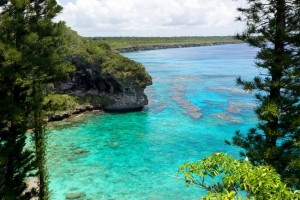The Loyalty Islands (Ouvéa, Lifou, and Maré) received their name from the early British trading companies who landed on the island, finding the locals to be honest and hard-working. These islands are secluded and quiet, significantly less populated than the larger New Caledonian archipelago, making an ideal getaway for those looking for true peace and serenity. Remnants of the islands’ colonial past are still fairly evident as you walk through the towns and villages; from villagers playing a sprightly game of cricket to the odd English and French words thrown throughout the native Melanese. Even though the islands are a French territory and French is understood, there are over 1,200 different dialects of Melanese the native Kanak and Tavu’avua’ people speak, some every varying from one island to the next.
The islands are still a well-kept secret, except among the diving crowd. Thanks to the lack of pollution and light human interaction, the lagoons, shores, and caves on the island are almost pristine in their cleanliness and natural beauty. Experienced divers will find a myriad of breathtaking underwater sights and challenging dives all along the coasts of each of the three Loyalty islands.

The island of Ouvéa is actually comprised of three islands: Ouvéa, Faiava, and Mouli, as well as the petite Pléiades islets. This island hosts one of the six stunning lagoons of New Caledonia listed as an UNESCO World Heritage Site, the Atoll d’Ouvéa, and was inducted in 2008. The rich and lush forests on Ouvéa island are home to the endangered Ouvéa green parakeet, which is in danger of extinction thanks to the pet trade and diseases brought to the island by rats on trade ships. The island’s beaches are just as stunning as its vibrant flora and fauna, relatively unspoiled by man and stretching the full 25 kilometers length of the land with unbelievable turquoise waters lapping at the sugar-white sand. Accomodations here and at any of the islands can vary from full luxury service, a room stay with a local welcoming Kanak family, all the way to campsites among the island’s natural resources.
Visiting divers will love the coral reefs at the Atoll d’Ouvéa lagoon, a reef stretching for over 1,600 kilometers and comparable only in size to the Great Barrier Reef off of neighboring Australia. This reef ecosystem holds over 350 different species of coral alone, not to mention the over 1,600 species of fish (one for every kilometer of the reef!). One dive and you’ll understand why the lagoon was inducted into the UNESCO World Heritage listing. In one of the marsh swamps on the island is another natural spectacle: a shark nursery where multiple species of native sharks come to reproduce, including reef and lemon sharks.

Lifou is the main island in this area, along with its smaller neighbor Tiga Island. The entire island of Lifou, and all the Loyalty Islands, is completely made up of fossilized coral, bridging the gap between land and sea. Lifou was once a sunken reef underwater and part of a lagoon, but over the years slowly rose out of the ocean. Because of this, the top of the island is flat with steep cliffs on all sides from the long-dead reefs. This island is a popular destination for Australian cruisers, but because of its small size does not have a full port to welcome them, but rather passengers are ferried by boat from the cruise ship to the shore. Divers will love the opportunity for a night dive, and because of the island’s natural reef construction, the waters here are full of beautiful fish, and private diving tours can be arranged before your arrival. For the non-divers in the party, consider exploring the Notre-Dame de Lourdes, a small Catholic chapel built by missionaries in the mid-19th century while the rest of your party goes deep into the ocean’s depths.
Maré, just like Lifou, is an atoll in a lagoon that eventually rose over 120 meters over time to become a full-fledged island. This island hides many secrets swimming spots, including sunken freshwater pools, but take care to wear shoes when walking as the fossilized coral can cut skin if you’re not careful. Take a walk through the La Ascien cliffs, watch local Kanak or Polynesian women weave baskets, or visit a local vanilla plantation to see how the fragrant spice is grown and cultivated, and even pick up some local vanilla-based products for yourself!
One of the most intriguing historical sights on Maré is the fortress of La Roche. This huge coral block was once a sanctuary for refugees looking to escape the religious fighting of the 19th century between the Catholics and the Protestants. The fortress is now overgrown with vegetation, but if you get a guide you can climb the slopes to the top.
To get your clients to New Caledonia, you can fly with Aircalin (SB/063) who is the proud international airline of New Caledonia. Aircalin has flights between Noumea and international destinations including service to Japan, Korea, Australia, New Zealand, Vanuatu, Fiji & Tahiti. A code share agreement is available between LAX and Noumea (NOU) with Air Tahiti Nui. Aircalin’s Business Class, the Hibiscus Cabin, is ideal for the luxury and business traveler looking to fly in style. Economy class on Aircalin is in a league of its own: aircraft are configured for maximum individual space, ensuring relaxation and comfort, and seats are equipped with adjustable head and foot rests. Travel agents can book via GDS. Published fares plated on Aircalin (SB) earn you 5% commission.
For more information, contact the Aircalin office in the United States:
Phone: 800-254-7251
Email: reservations@aircalin.us
Aircalin Website: www.us.aircalin.com
To learn about New Caledonia, visit: www.office-tourisme.nc




